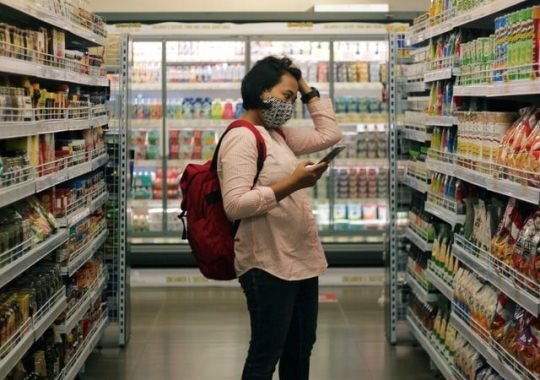- Pandemic outbreaks in critical links of global supply chains have resulted in longer than expected supply disruptions, feeding inflation in many countries
- Global manufacturing activity has been rocked by supply-demand mismatches and shortages of key components, clogged ports, a lack of cargo containers, and a labor crunch as global supply chains remain in disarray after pandemic-induced shutdowns last year
- The advanced economy group is expected to regain its pre-pandemic economic trend path in 2022 and exceed it in 2024
- The emerging market and developing economy group is expected to remain below pre-pandemic economic trends due to slower vaccine rollouts and generally less policy support
The worsening supply chain situation and ongoing pandemic pressures have prompted the International Monetary Fund (IMF) to trim its growth forecast for the global economy in 2021, citing risks associated with debt, inflation and divergent economic trends.
In its latest World Economic Outlook (WEO) released October 12, the IMF projects the global economy to grow 5.9% in 2021 and 4.9% in 2022, a slight downward revision from earlier projections.
“The global recovery continues but momentum has weakened, hobbled by the pandemic. Fueled by the highly transmissible Delta variant, the recorded global COVID-19 death toll has risen close to 5 million and health risks abound, holding back a full return to normalcy,” said Gita Gopinath, IMF economic counsellor and director of research.
“Pandemic outbreaks in critical links of global supply chains have resulted in longer than expected supply disruptions, feeding inflation in many countries. Overall, risks to economic prospects have increased and policy trade-offs have become more complex,” she dded.
The modest headline revision for 2021 from the outlook in July masks large downgrades for some countries, however. The outlook for the low-income developing country group has darkened considerably due to worsening pandemic dynamics. The downgrade also reflects more difficult near-term prospects for the advanced economy group, in part due to supply disruptions.
These divergences are a consequence of the “great vaccine divide” and large disparities in policy support, the IMF said. While almost 60% of the population in advanced economies is fully vaccinated and some constituents are now receiving booster shots, about 96% of the population in low-income countries remains unvaccinated.
Furthermore, many emerging market and developing economies, faced with tighter financing conditions and a greater risk of de-anchoring inflation expectations, are withdrawing policy support more quickly despite larger shortfalls in output.
Supply disruptions pose another policy challenge. Pandemic outbreaks and climate disruptions have resulted in shortages of key inputs and lowered manufacturing activity in several countries.
Moreover, these supply shortages, alongside the release of pent-up demand and the rebound in commodity prices, have caused consumer price inflation to increase rapidly in, for example, the United States, Germany, and many emerging market and developing economies. Food prices have increased the most in low-income countries where food insecurity is most acute, adding to the burdens of poorer households and raising the risk of social unrest.
At the same time, global manufacturing activity has been slammed by supply-demand mismatches and shortages of key components such as semiconductors, clogged ports and a lack of cargo containers, and a labor crunch as global supply chains optimized for efficiency remain in disarray after pandemic-induced shutdowns last year, according to a Reuters report.
The United States is taking the brunt of these effects, and the IMF slashed its 2021 US growth forecast by a full percentage point, to 6.0%, from 7.0% in July—a level that was seen as the strongest pace since 1984.
In Asia, China’s prospects for 2021 are marked down slightly due to stronger-than-anticipated scaling back of public investment. India’s forecast was unchanged at 9.5%, but prospects in other emerging Asian countries have been diminished due to a worsening of the pandemic.
The IMF cut its forecast by 1.4 points for the “ASEAN-5” grouping of Indonesia, Malaysia, the Philippines, Singapore, and Thailand.
Aggregate output for the advanced economy group is expected to regain its pre-pandemic trend path in 2022 and exceed it by 0.9% in 2024—largely reflecting sizable anticipated further policy support in the United States that includes measures to increase potential.
By contrast, aggregate output for the emerging market and developing economy group (excluding China) is expected to remain 5.5% below the pre-pandemic forecast in 2024 due to slower vaccine rollouts and generally less policy support compared to advanced economies, resulting in a larger setback to improvements in their living standards.
“Recent developments have made it abundantly clear that we are all in this together and the pandemic is not over anywhere until it is over everywhere. If COVID-19 were to have a prolonged impact—into the medium-term—it could reduce global GDP by a cumulative $5.3 trillion over the next five years relative to our current projection. It does not have to be this way. The global community must step up efforts to ensure equitable vaccine access for every country, overcome vaccine hesitancy where there is adequate supply, and secure better economic prospects for all,” said Gopinath.
Photo by Viki Mohamad on Unsplash









